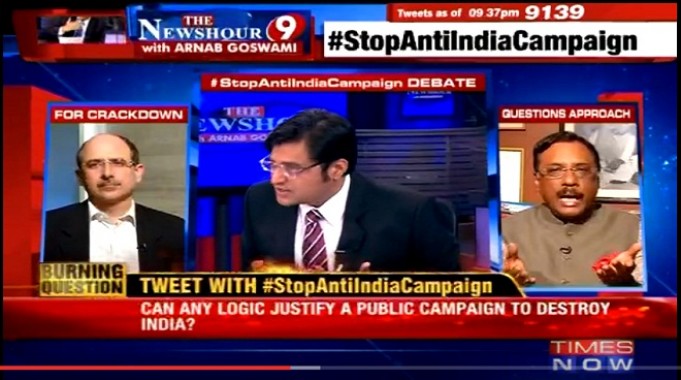The art of manufacturing nationalist outrage
Newshour Debate on 15th Feb 2016
Its hard to tell who hurts the media more as an institution—those who have tacit police sanction to attack reporters, or the high visibility few within the media who exploit events in their professional practice. Because the latter is what Arnab Goswami’s current orchestrated anger at anti-India sloganeering in JNU, amounts to. (It changes, as we know, the target of this orchestration.)
When the police stand by and watch reporters and other citizens getting roughed up, even beaten in a court premises in the heart of the capital city, it is a grimreminder of the hardening stance of the government of the day. And just last week in Jagdalpur in Chattisgarh a professed citizens’ group with proven police patronage, threw stones in the middle of the night at the property of a woman reporter to intimidate her. That’s one kind of threat to a liberal ethos, masquerading as nationalism.
The other comes from Times Now which has no qualms at all about whipping up provocation for its daily quota of controversy. The anchor is a high decibel referee, and the referee reserves the right to queer the pitch as much as he can.
When Goswami gets going, the facts are irrelevant. You can sit back and view it as entertaining theatre if your blood pressure can take it, or you can wonder at what it is feeding into. One online video on a JNU-related edition of Newshour on YouTube drew 7000 plus comments with much communal and racial hatred on display. Evidently the Times Group does not have a problem with the damage their anchor and channel can do.
For the last few days there has been relentless whipping up of anti-student sentiment, night after night. A video of fairly bizarre anti-national sloganeering on the JNU campus would not get very far without the help of Times Now. But on February 15 the channel quickly made it something to be flogged, something that could provoke Goswami to holler, “Since when did warnings of snatching away Kashmir at gunpoint qualify as freedom of expression?”
As rival and sometimes clone Zakka Jacob was pointing out on CNN IBN the same evening, TV channels should not be circulating provocative unverified videos. But Goswami ran it, with an occasional disclaimer on the screen which said, Delhi Police is verifying this video, or words to that effect. How expedient. If those being berated on his show couldnot point that out effectively, it is because they could not get a word in edgeways.
When Goswami is on a calibrated nationalism high, he is creative about the issues he conflates. When the soldier buried under snow in Siachin was fighting for his life in Delhi he became a convenient motif for the anchor to contrast with students mouthing “desh ki barbadi” on a JNU campus.
“…Lance Naik Hanumanthappa... We are proud of him and ashamed of you. You will not speak over me when I am talking about Lance Naik hanumanthapa…You sit on the JNU campus and tell people you will work hard and destroy India…Don’t you dare speak over me when I speaking about Lance Naik Hanumanthappa…These students cannot be allowed to disgrace our campus any more.”
His commercially successful style is a problem because he is watched widely online even if English news channel viewership is miniscule compared to Indian language channels. And because he is imitated. Rahul Shiv Shankar of News X who came from the Times Now stable is one wannabe, Zakka Jacob on CNN IBN is another, in terms of the snarling aggression he can unleash.
Goswami’s angry-at-corruption, angry-at-anti-nationalism construct allowed him to claim in an interview on his channel’s tenth anniversary that the channel has had “perceptible impact on the political processes in the country: that is change.”
How seriously should one take the bluster? TV news informs little, it could be ignored if it did not influence. But his rants against free speech advocates cheerfully distort facts, and who is to protest? Pratap Bhanu Mehta gets a side swipe presumably on account of his piece in the Indian Express of a few days ago. “Semi academics write half baked... pieces in newspapers saying free speech.” We are told that Mehta and others said nothing about the free speech violations under the United Progressive Alliance regime, that none of those currently incensed about what is happening on the JNU campus uttered a word about Aseem Trivedi’s cartoons being dubbed seditious, or about the girls in Maharashtra who were targeted by the police for their Facebook posts.
None of that is true but who is challenging any of it in real time? Tabloid television and nationalism is a deadly combination. Who will counter it?
First published in Catch News
Sevanti Ninan is a media commentator, author, and editor of TheHoot.org








